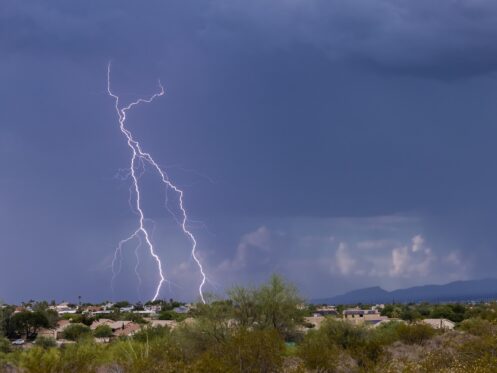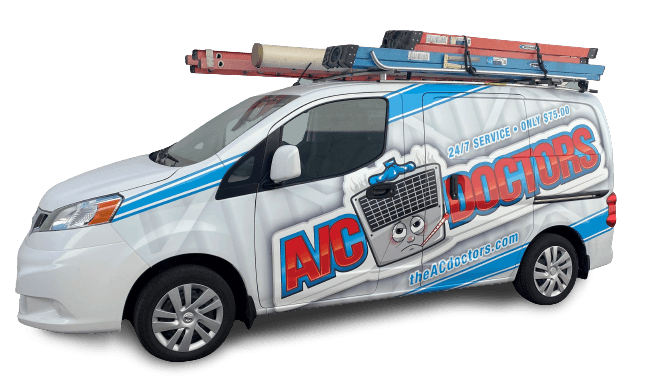As monsoon season sweeps across the state, its impact extends beyond the outdoors. Monsoon season plays a significant role in influencing your home’s living environment. The extra humidity in the air during the monsoon season can create an uncomfortable home environment when traveling indoors. At A/C & Plumbing Doctors, a trusted expert in Gilbert, AZ, we specialize in helping homeowners manage the elevated humidity in their homes. Our solutions ensure a cool living space while preventing mold growth and musty smells. Learn more about why monsoon weather patterns negatively affect your indoor air quality and what you can do to prevent it.
Understanding Monsoon Weather Patterns
Understanding monsoon weather patterns is crucial for determining its impact on indoor humidity levels. Monsoon season involves a shift in wind patterns that comes with heavy rain. The monsoon climate comes with a wet and dry phase. During the wet phase, warm air, dripping in moisture, moves from the ocean onto the land and increases the atmospheric moisture. This extra moisture can raise indoor humidity levels and make homeowners feel uncomfortable and sticky.
The best way to combat this weather pattern is to find ways to lower indoor humidity levels. During the dry phase, homeowners may experience too little humidity and need to find ways to raise the moisture level in their homes. This phase, however, tends to be more short-lived and creates less of a burden for homeowners in the area as a result.
Monitoring Indoor Humidity Levels During Monsoon Season
Monitoring indoor humidity levels during monsoon season helps ensure comfort in your home and prevents any potential issues such as mold growth. The increased moisture in the air during monsoon periods can create elevated humidity levels indoors, especially if you have a poorly ventilated home.
Checking your humidity levels regularly using a hygrometer will make it possible for you to gauge indoor conditions accurately. Indoor humidity levels should be between 30% and 50% to avoid mildew and mold growth as well as uncomfortable dryness. Purchasing a hygrometer and monitoring your humidity levels can protect your home. If you notice that your humidity levels are too high or too low, you can take proactive measures to either add moisture to the air or remove it.
Tips for Controlling Humidity With Natural Ventilation
Yes, natural ventilation can play a significant role in controlling humidity levels in your home. Opening windows and doors strategically during periods of lower outdoor humidity can help move higher-humidity air outdoors while bringing lower-humidity air in. A great time to open windows and doors is after a heavy rain or in the early morning. The air after a heavy rain and in the early morning tends to be lower in humidity.
Cross-ventilation is also a wonderful strategy for removing excessively humid air from your home. When windows on opposite sides of the room are opened, airflow is more active and can help lower humidity. Using exhaust fans in kitchens and bathrooms also helps expel humid air generated from cooking or bathing. These natural ventilation methods can help maintain optimal indoor humidity levels and promote air circulation. However, natural ventilation methods may not be enough to lower your humidity levels to the 30% to 50% optimal range.
Using Dehumidifiers Effectively in Monsoon Climates
Using dehumidifiers effectively in monsoon climates can help you manage your indoor humidity levels in a way that other natural strategies cannot. Dehumidifiers are particularly effective when there is a high atmospheric moisture content, such as during monsoon season.
Dehumidifiers work by extracting excess moisture from the air to limit dampness and mold that can grow in your home. Place one to two dehumidifiers in areas where moisture builds up the most, such as basements, laundry rooms, kitchens, and bathrooms. You can purchase a standalone dehumidifier or add a whole-house dehumidifier. We can help you choose the best dehumidifier system for your home and install it for you.
We recommend opting for dehumidifier models that have adjustable humidity settings so that you can maintain a consistent temperature that works best for your home. You may find that 30% humidity is too low and you would prefer to be closer to 50%. Playing with these levels will help you find a comfortable fit for you and your family.
Preventing Mold and Mildew Growth Indoors
When humidity levels are higher, preventing mold and mildew growth indoors is more difficult during monsoon season. The best way to prevent mold and mildew growth is to work to lower humidity levels throughout your home. This is particularly the case in the areas where mold is most likely to grow, such as bathrooms, basements, laundry areas, and kitchens.
You can use your exhaust fans to help ventilate when showering or cooking. You can open windows and doors to promote cross-ventilation. You can use a whole-house dehumidifier or several smaller units to pull moisture out of the air. Mildew and mold thrive at 50% humidity and above. In order to prevent their growth, we recommend also using a hygrometer to ensure that your home’s humidity levels stay below 50%.
Using Indoor Plants to Help Regulate Humidity and Help Your AC Unit
Indoor plants can also help you regulate the humidity in your home and help your AC unit. There are certain plants that help to pull moisture from the air naturally. Adding a few to your home can be a cost-effective way to support your dehumidifier and HVAC system. We recommend choosing spider plants, peace lilies, or Boston ferns to boost your home’s indoor air quality with their natural dehumidification properties.
Placing these plants near windows or in areas where you need shade can also help with your cooling needs by lowering the temperature in those areas with shade. Incorporating humidity-regulating plants into your indoor spaces enhances air quality. It also complements your AC unit’s efforts in maintaining a comfortable and balanced indoor environment throughout varying weather conditions, including the monsoon season.
Professional HVAC Help During Monsoon Season
Seeking professional HVAC help during the monsoon season is a great way to make sure that your system is primed and ready to handle the season’s additional demands. HVAC technicians can perform essential maintenance tasks such as inspecting and cleaning your ductwork and checking refrigerant and humidity levels. They can also diagnose and repair any issues that could compromise your indoor air quality and, therefore, your comfort. HVAC technicians can also help you select and install dehumidifier units or a whole-house dehumidifier that works to keep your indoor humidity levels comfortable and healthy.
Contact Us Today
Navigating the effects of monsoon weather on indoor humidity requires proactive measures and awareness. Implementing the above strategies can help you manage humidity levels in your home during this time. Whether through natural ventilation techniques, maintaining your HVAC system, or using a dehumidifier, there are ways to combat the excess moisture. Remember, a well-regulated indoor space is better for your health and protects the structural integrity of your home.
At A/C & Plumbing Doctors, we can help with all residential and commercial AC unit installation, repairs, replacement services, indoor air quality, garbage disposal, ductwork, VRF/ERV/VRV systems, and plumbing services. Need help with your humidity levels? Contact us today.





